Great article i really like it, As an alternative to Grundfos or Wilo "smart" pumps, you might like to look at what you have to offer for residential applications.
Blog Post
Grundfos (and Wilo) "Smart" Circulator Pumps for Hydronic Heating
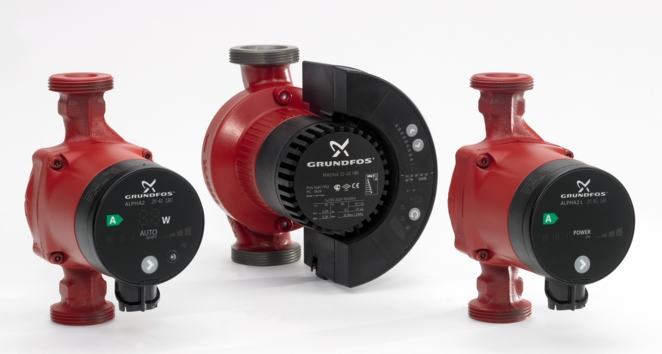
For the past couple years, I've been helping All Soul's Church in West Brattleboro, Vermont, save energy. While developing a plan to improve the performance of the building envelope of this early-1970s, heavily glazed and horribly inefficient building, one of our committee members found out about a grant program from the state that would support a heating system upgrade.
To make a long story short, we replaced the massive oil-fired boiler with a compact Buderus model that takes up just a fraction of the space; we got rid of the 6,000-gallon underground storage tank, replacing it with two 330-gallon tanks in the boiler room; we replaced the failed zone valves with new thermostatically controlled, electric zone valves; we stopped using the boiler to make hot water for three small lavatory sinks (for which the boiler would operate off-and-on all summer); and--the topic of this blog--we replaced the constant-speed, 1-horsepower (hp) pump with a high-tech pump from Denmark that should dramatically reduce the electricity we use for circulating hot water.
The pump we installed is a variable-speed Grundfos Magnawith ECM motor and a unique AutoAdapt feature that uses an integrated logic board to "learn" the building's usage patterns and calibrate the pump operation accordingly.
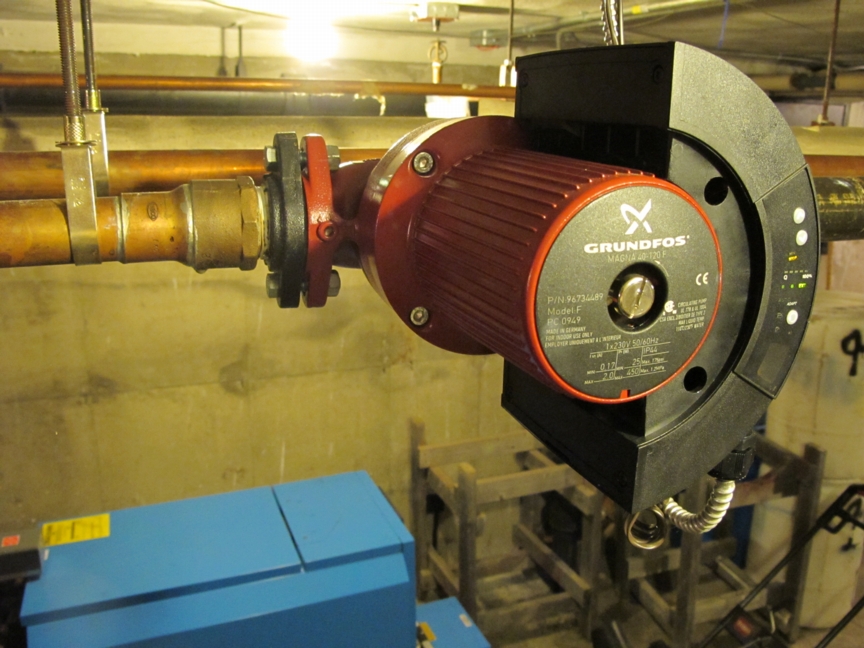
To understand why this pump is pretty cool, let me explain how the hydronic heating system used to "work" at the church ("work" is intentionally in quotes). The oil-fired boiler heated water that was circulated through a primary loop in the basement and crawl space. Zone valves (which were user-adjusted at the baseboard radiators) employed a paraffin material to passively open when heat was called for and close when heat wasn't needed (at least that was the theory). The 1-hp pump operated nearly continuously throughout the heating season, and because most of the old zone valves were stuck open, the church was kept fully heated most of the time. The church used about 6,000 gallons of oil per year.
The replacement electric zone valves now allow the hot water flow to be cut off to radiators, so we can actually set back the temperatures in different rooms in the church. That improvement, alone, should produce very significant energy savings.
But the new, high-tech pump is also pretty neat and will result in significant electricitysavings. A 1-hp pump uses about 750 watts when its on. Operating 24/7, such a pump uses about 550 kilowatt-hours (kWh) per month--about $70 worth at our current electricity rates. The variable-speed Grundfos pump we installed senses how hard it has to work to circulate water around the building, and it doesn't work as hard when less water is being circulated.
SUPPORT INDEPENDENT SUSTAINABILITY REPORTING
BuildingGreen relies on our premium members, not on advertisers. Help make our work possible.
See membership options »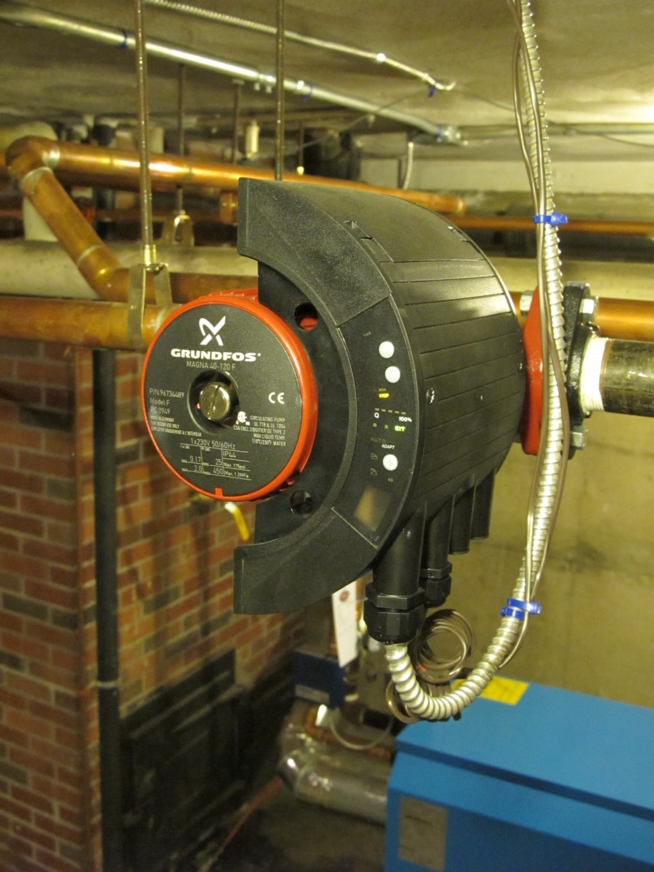
At night and during other periods when heat isn't being called for, water is circulating only through the primary hydronic loop; the zone valves are closed so hot water isn't being diverted up into the church and through the baseboard radiators. In this condition, the pump controls throttle it way back, so water is circulated much more slowly and pumping energy is greatly reduced.
The Grundfos Magna pump has a sophisticated variable-speed drive as well as an "electronically commutated motor" (ECM) which makes it significantly more efficient.
The AutoAdapt feature in the Grundfos Magna (and a companion Alpha line for smaller residential heating systems) uses special algorithms in the processor to anticipate when heat will be called for and ramp the pump speed up or down accordingly. Frankly, I don't understand how this works, and I haven't been totally convinced of the benefits--but the company is very proud of the feature.
Grundfos is not the only company offering advanced, variable-speed ("Smart") pumps. German manufacturer Wilo (pronounced "veelo") has a similar product. The Wilo Stratos (for commercial buildings) and Stratos ECO(for smaller residential applications) pumps were actually introduced to the U.S. market a few years before the Grundfos Magna and Alpha pumps, and they work on much the same principle--though without the AutoAdapt feature.
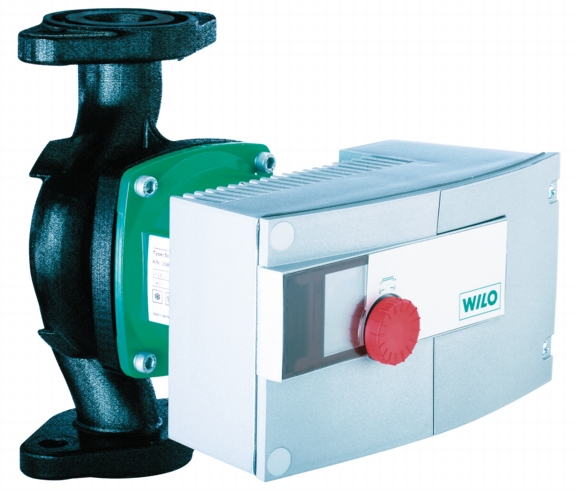
A sales rep at Grundfos told me that their residential Alpha pumps are about three times as expensive as standard constant-speed circulators, while their Magna pumps cost about 50% more than standard circulators. Someone at Wilo told me the cost of their Stratos and Stratos ECO pumps are two to two-and-a-half times that of standard circulators. The payback for these pumps (assuming electricity savings only) can range from eight months to about three years, according to representatives from both companies.
These variable-speed, ECM circulators make a lot of sense for several reasons. One, they allow you to save pumping energy by varying the flow rate. Two, by reducing the flow they can increase the temperature difference between water leaving the boiler and water returning--which improves efficiency, so you use less heating fuel. (With a condensing boiler, this higher delta-T allows the boiler to truly operate in a condensing mode during swing seasons when less heat is being extracted out of the hydronic loop; often during those seasons, boilers stop operating in the condensing mode and their efficiency drops about 8%.) And three, these pumps compensate for the fact that circulator pumps are almost always significantly oversized.
According to Grundfos and Wilo, these variable-speed pumps with ECM motors can reduce pumping energy by 70-90 percent--and that's a lot of electricity savings. Worldwide, pumping accounts for about 22% of all electricity use, according to Steve Thompson, the vice president for building services at Wilo USA!
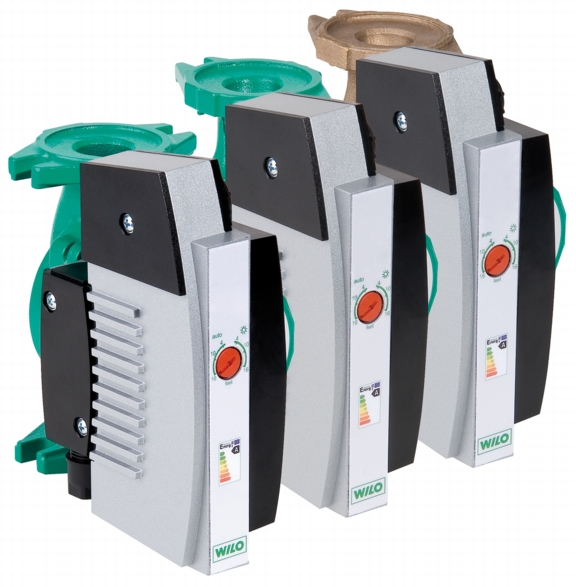
The point about oversizing pumps is an important one. In most buildings, according to hydronic heating expert Henry Gifford, the level of savings we will achieve with the high-tech (expensive) variable-speed pump can be more cheaply achieved simply by right-sizing a constant-speed circulator. The reality, however, is that most heating contractors don't do actual calculations for pumps (most probably don't even know how to do those calculations), preferring to cover themselves by significantly oversizing the pumps. For this reason, this new generation of advanced smart pump makes a lot of sense.
In the September issue of Environmental Building News, we'll be running a more in-depth article about smart pumps from both Grundfos and Wilo.
For more information:
Grundfos USA
Olathe, Kansas
913-227-3400
Wilo USA
Melrose Park, Illinois
866-945-6872
See more on Grundfos Pumps in the GreenSpec Guide
See more on Wilo Pumps in the GreenSpec Guide
Alex Wilson is the executive editor of Environmental Building News and founder of BuildingGreen, LLC. In addition to this product-of-the week blog, he writes the weekly Energy Solutions blog. To keep up with his latest articles and musings, you can sign up for his Twitter feeds. Products covered in his product-of-the-week column are--or soon will be--listed in BuildingGreen's GreenSpec Directory.
Published August 12, 2010 Permalink Citation
(2010, August 12). Grundfos (and Wilo) "Smart" Circulator Pumps for Hydronic Heating. Retrieved from https://www.buildinggreen.com/blog/grundfos-and-wilo-smart-circulator-pumps-hydronic-heating
Comments
Hello, What is the difference
Hello,
What is the difference between these smart pumps and say, controlling a pump/motor with either your own pulse width modulation or using a DC brushless motor?
As a homeowner installing a radiant system, I would love it to find components that would let you set your own control preferences without having to make your own circuit board, for example, a pump and control module that lets you program a PID controller (gain, integral, diff) coefficients or upload your own control algorithm based on your favorite control variables and system identification (delay, poles, zeros, ..). Does that exist?
BTW, the Grundfos Magna circulator UI looks great! nice design.
Hi Alex, Great article.Just c
Hi Alex,
Great article.Just curious if anything needs to be done with the flow switch for the boiler if the circulation slows down in low demand periods.Also any issues for balancing the system?
Thanks
Rob
Rob, I'm not aware of any suc
Rob,
I'm not aware of any such boiler adjustments that are needed, but it's worth checking with a manufacturer's rep or mechanical engineer. As for balancing the system, if some areas of the building are pulling hot water off the main hydronic loop further downstream, the zone valves may stay open longer to get those rooms up to the set temperature, but I don't think balancing is an issue. Balancing comes into play more with forced-air systems and pressure differentials.
Marcus As an alternative to G
Marcus
As an alternative to Grundfos or Wilo "smart" pumps, you might like to look at what Taco have to offer for residential applications. Their website - www.taco-hvac.com - is very clean, easy to navigate and shows technical info and diagrams.
[BTW: I have no connection with this company other than a registration for tech updates over the Web]
Marcus, Switching from your t
Marcus,
Switching from your three constant-speed circulators to one Wilo or Grundfos VFD pump would necessitate some changes to your plumbing connections. The cost of that may make the economics unattractive. On the other hand, if pump noise is a concern currently, that might become much less of an issue. I'm thinking of the same conversion myself at home, but haven't done that yet.
Alex - I understand the valu
Alex -
I understand the value that the Grundfos or WIlo pump can add in a large building but I am struggling to project that into my home. I am about to have a new boiler installed and the contractor will be replacing all three of our circulating pumps (others have suggested 1 pump and 3 electronic zone valves). The contractor is offering either "std" pumps or "high efficiency" and has referenced the energy savings. For our house (~3100 ft + heated basement) I have only seen the circulators running when the boiler was firing. My electricity bill in the winter is minimal so will thee expensive high efficiency pumps really have a reasonable payoff period (ideally 3 yrs or less)?
Thanks,
Marcus
Alex, The pump cost figures y
Alex,
The pump cost figures you quote are yet another example of the typical 2 to 3 times premium over regular equipment that puts many people off going green. I am forever explaining that you have to pay more up front, if you want to save down the line.
Unfortunately, many developers who want to build and sell are not interested in what the buyers are going to save on their bills, so they still fit the regular gear - and will continue to do so until energy saving regulations force them to do otherwise.
Hi, Alex: I was happy to read
Hi, Alex:
I was happy to read that your recent experiences with the Grundfos Magna and ECM technology turned out so positive. Whoever pays the electric bills at All Soul's will likely appreciate the results. If you would ever care to delve more deeply into the intricacies of AutoAdapt, please let me know. I would be happy to connect you with Grundfos senior product manager Bob Reinmund, who is adept at presenting complex technical concepts in a straightforward manner.
Thank you for the interesting write-up.
John O'Reilly
O'Reilly/DePalma
Alex, I read your excellent a
Alex, I read your excellent article with great interest (I am the VP of Building Services market segment for WILO USA). If you have any questions or comments I can be reached directly at steve.thompson@wilo-usa.com.
These are exciting times to be sure – I see variable speed “smart” ECM pumps as after 36 years in the industry as the last (or next) horizon in pump and system efficiency. Interestingly, my prediction is we will move from zoning with circs back to the old way of zoning with valves now that smart circs react to valves opening and closing (they reduce differential head as zones close, the opposite of constant speed circs). In reality I am aleady seeing this take place (and very few pressure compensated by-pass valves used).
To respond to some of the posts:
Low flow effecting flow switches and low mass boilers:
These smart pumps have two typical operating modes. One is delta PV where the differential head at zero flow is ½ half of the head at full speed. If that setting causes issues with boilers or flow switches (I have not seen any in the 3 years we have selling the Stratos) the pump can be set to run on constant pressure, increasing the delta P at low flows.
Energy savings on residential systems:
I agree $50 to $80 dollars electrical savings a year is tough to justify 3 times the cost of a conventional residential circ but a difficult to calculate saving is operation the system at a better, more efficient delta T. Potentially lowers the water temp and for sure will reduce boiler cycling (especially during low heat demand times).
The government (DOE, Energy Star etc) is extremely interested in the fact that there are estimated to be 1.5 to 2 million of these circs running in the USA during the heating season (based on annual sales volumes and average life of 10 years). If these were all ECM that would save the equivalent energy that 500,000 homes use in one month or 1400 tons of carbon emissions. In addition, generating the extra 2 billion watts the old style circs consumes 2 million gallons of water (2 gallons per kW) every year.
I am chairing a new “Fluid Pump” section of AHRI and we are going to write an energy efficiency standard - and that will tie into government “cash incentives” for using this new technology. - stay tuned.
Great article – please keep them coming!
I've fixed the reference to t
I've fixed the reference to the Alpha2, so it now reflects the proper terminology for North America (Alpha). I'm wrapping up a more in-depth article on these pumps for the September issue of Environmental Building News. Watch for that in a couple weeks.
Alex: Thanks for making folks
Alex:
Thanks for making folks aware of the possibilities for energy savings by using "smart pumps" like Alpha and Magna. Your reference to "Alpha 2" is actually the European version of the pump-we took the time to design an Alpha for the North American market. The link to the US/North American site is www.poweredby.grundfos.com.
Thanks again for helping spread the word!
As an alternative to Grundfos
As an alternative to Grundfos or Wilo "smart" pumps, you might like to look at what Taco have to offer for residential applications. Their website - www.taco-hvac.com - is very clean, easy to navigate and shows technical info and diagrams.
----------------------------------------
yeah I agree with you Taco pumps good circulator pumps for me last 3 years!



Add new comment
To post a comment, you need to register for a BuildingGreen Basic membership (free) or login to your existing profile.